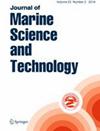Smart Sounding Table Using Adaptive Neuro-Fuzzy Inference System
IF 2
4区 工程技术
Q2 ENGINEERING, CIVIL
引用次数: 0
Abstract
Marine engineers measure the liquid level (sounding depth) to calculate the volumetric content of a ship's tank. The sounding depth is determined using an ullage pipe located at specific points on the tanks. To estimate the accurate volume of liquid, considering the ship's trim and heel conditions, engineers use a tank table (sounding table) consisting of hundreds of pages. However, this method is time-consuming and lacks intermediate values for sounding depth, trim, and heel. Ship designers recommend to use linear interpolation for intermediate values, yet this process is also time-consuming. This paper proposes the implementation of an Adaptive Neuro-Fuzzy Inference System (ANFIS) to digitize the sounding table. To our knowledge, we are the first to apply the ANFIS method to develop a model for liquid volume in non-uniform geometric tanks, accounting for different trim and heel conditions of the vessel. In this study, the digitization of the sounding table using ANFIS is referred to as the Smart Sounding Table (SST). SST's accuracy is validated against experimental values, revealing an R-squared value of 0.9999, a mean absolute percentage error of 0.3515, and a root mean square error of 0.0366. These metrics clearly show that the SST algorithm accurately and reliably models experimental data. Marine engineers input three parameters (sounding depth, trim, and heel) into the SST, enabling rapid and accurate determination of liquid volume in their tanks, without the need for interpolation or exhaustive page searches.基于自适应神经模糊推理系统的智能测深表
轮机工程师通过测量液位(探测深度)来计算船舶油箱的容积。探测深度是使用位于储罐上特定点上的一根管子来确定的。为了准确估计液体的体积,考虑到船的侧倾和后跟的情况,工程师们使用了一个由数百页组成的水箱表(测深表)。然而,这种方法耗时长,并且缺乏测深、纵度和跟高的中间值。船舶设计师建议使用线性插值的中间值,但这个过程也很耗时。本文提出了一种自适应神经模糊推理系统(ANFIS)来实现测深表的数字化。据我们所知,我们是第一个应用ANFIS方法开发非均匀几何容器中液体体积模型的公司,该模型考虑了容器的不同装饰和鞋跟条件。在本研究中,使用ANFIS对测深表进行数字化,称为智能测深表(SST)。根据实验值验证了SST的精度,r平方值为0.9999,平均绝对百分比误差为0.3515,均方根误差为0.0366。这些指标清楚地表明,SST算法准确可靠地模拟实验数据。船舶工程师在SST中输入三个参数(测深,纵倾和跟),从而可以快速准确地确定储罐中的液体体积,而无需插值或详尽的页面搜索。
本文章由计算机程序翻译,如有差异,请以英文原文为准。
求助全文
约1分钟内获得全文
求助全文
来源期刊

Journal of Marine Science and Technology
工程技术-工程:海洋
CiteScore
5.60
自引率
3.80%
发文量
47
审稿时长
7.5 months
期刊介绍:
The Journal of Marine Science and Technology (JMST), presently indexed in EI and SCI Expanded, publishes original, high-quality, peer-reviewed research papers on marine studies including engineering, pure and applied science, and technology. The full text of the published papers is also made accessible at the JMST website to allow a rapid circulation.
 求助内容:
求助内容: 应助结果提醒方式:
应助结果提醒方式:


